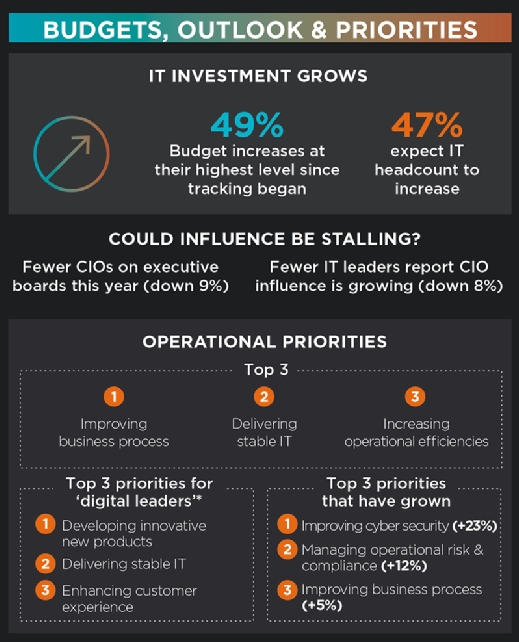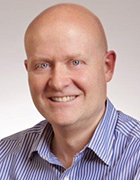
rost9 - stock.adobe.com
IT spending reaches 10-year high as CIOs struggle with digital technology strategy
IT leaders have seen their budgets and headcounts rise for the first time in 10 years, but face challenges implementing their digital strategies
CIOs are reporting increases in IT spending and staffing as their organisations step up investments in digital technology.
Nearly half of IT leaders have seen their budgets and headcounts rise over the past 12 months, the highest increase reported in over a decade.
But many CIOs admit they are struggling to introduce an effective digital strategy across their organisations, a survey of nearly 4,000 IT leaders across 84 countries has revealed.
Nearly half of IT leaders expect budgets to continue to rise over the next 12 months, in what is seen as a return to “business as usual”, according to research by Harvey Nash and KPMG.
Cyber security and privacy has been one of the biggest growth areas as companies step up their spending to comply with the General Data Protection Regulation (GDPR), which came into force in May 2018.
With cyber attacks at an all-time high, almost a quarter of boards are prioritising spending on cyber security, while managing operational risk has become a significantly higher priority over the past 12 months, the survey found.
“GDPR has made security more of a board issue for the past six to 12 months, because [the deadline of] 25 May concentrates people’s minds. It raises the whole profile of handling of personal data. The mandatory breach notification also makes people stop and think,” said David Ferbrache, chief technology officer in KPMG’s cyber security practice.
Customer-centric focus
The research found that the most profitable organisations had taken steps to rebuild their operations around the needs of their customers, creating new opportunities for CIOs.
Lisa Heneghan, global head of technology for management consultancy at KPMG, said IT leaders were building their influence by thinking more about the way the company interacts with customers.

“In organisations where they are being really effective, we are starting to see CIOs thinking in that very different mindset – not thinking about the budget they control, but thinking of the impact of the things they do on the external market and their customers,” she said in an interview with Computer Weekly.
Building a customer-centric business also means ensuring that IT systems are stable and reliable, one of the three top priorities for company boards in 2018, the research revealed.
Executives are also asking CIOs to focus more on improving their organisation’s business processes and the efficiency of day-to-day IT operations.
“The second most important thing, even for the customer-centric, is you need a stable and safe IT platform, otherwise everything else is irrelevant,” said Heneghan.
The cost for companies that get it wrong is high. In April 2018, customers of TSB lost money from their accounts following an IT upgrade, while in May 2018, users of Visa cards were unable make payments following a hardware failure. Both of these instances caused potentially damaging national publicity.
CDOs are key to digital strategy
While IT leaders feel they have a strong understanding of the impact of technology on their industry, they feel less confident that they have an effective vision in place to use digital technology to transform their own organisations.
The most successful companies employ both CIOs and chief digital officers (CDOs) who work in tandem to take advantage of innovative technology.
What CIOs say: Kevin Robins, CIO, Sage UK

“Just as boards have become more technically aware, the onus is on IT to become more business aware. IT needs to partner with the business and move up the value chain from being a service”
Half of organisations with a dedicated CDO and over 40% of organisations with an acting CDO reported having a clear enterprise digital strategy, compared with only 21% without a CDO.
More importantly, these companies were more likely to be redesigning their company’s business processes to take advantage of digital technology than those with CIOs alone.
CDOs may be more likely to have a board-level position than CIOs, but this does not mean CIOs are losing influence in their organisations, said Heneghan, with up to a third of CDO posts filled by CIOs, she said.
“It’s about seeing the CDO as acting as a catalyst to help them in their organisation. It is a broad role. There is nothing wrong with saying you need more than one person to deal with it,” said Heneghan.
CIOs come out of the shadows
The accelerating trend for parts of the organisation outside the IT department to invest in their own IT systems is leading to further changes in the role of IT leaders.
Two-thirds of those surveyed said more than 5% of their IT spending was now managed outside of the traditional IT department. Nearly 45% said more than 10% of IT spending was outside the traditional IT department.
CIOs are responding by swapping control for greater influence within their organisations, by offering support to departments rolling out their own technology, said Heneghan.
What CIOs say: Markus Sontheimer, CIO, DB Schenker

“There is no distinct technology function any more. Keeping control of the enterprise architecture is key – we must bring technology to all parts of the organisation”
“The challenge for CIOs is how you can get the right governance in place, how you can get the right level of influence to protect an organisation from an increasingly challenging environment and drive that culture of conformance, which is a hard thing to do,” she said.
Albert Ellis, chief executive of Harvey Nash Group, said CIOs needed to watch the way technology is influencing developments in the market closely.
In the grocery industry, for example, companies such as Hello Fresh, which delivers ingredients and recipes to people’s doors, could have a long-term impact on supermarkets.
“If you are in the grocery sector, my suggestion is you should understand exactly why people are using Hello Fresh and not going to visit the supermarkets, or why they are doing a bit online, a little bit locally and much less in the large out-of-town supermarkets,” he said.
The cost of digital skills
One of the biggest challenges for CIOs is finding skilled developers with the big data analytics skills they need at a price they can afford.
Almost two-thirds of IT leaders said a lack of people with the right skills was preventing their organisations from keeping up with rapid pace of change in technology.
What CIOs say: Claudine Ogilvie, CIO, Jetstar Airways

“The technology lifecycle is not just becoming shorter, but it has become a continuously evolving part of the fabric of our business. There is an industry-wide shift towards agile operating models and ways of working to make technology and the business one and the same”
Companies are seeking experienced data scientists, often from Ivy League universities with degrees in mathematics – but “they simply don’t exist”, said Ellis.
And if they do exist, they are already working for Google, Apple or Facebook, companies that can afford to pay top rates.
More CIOs are turning to contractors to fill the gap, with 35% reporting that they are using them “to a great extent”.
And almost half are looking to automation and robotics technology to reduce the need for additional headcount. Outsourcing is another option.
With competition for IT skills likely to increase, Ellis advised CIOs to hire a cohort of young, skilled technology graduates, and have them on board to learn the skills that will become important to the business over the next five years.
What CIOs say: Amitabh Apte, director of digital foundations integration, Mars UK

“Technology has evolved from something which happens in the datacentre to something that happens on people’s desks through cloud and SaaS [software-as-a-service] apps”
CIOs will also need to educate the board that in an era of stagnant wages, they are going to have to make an exception to pay for IT staff with business-critical skills.
“Companies complain about skills shortages, but sometimes they mean they just won’t address the fact that the types of people they want don’t come at the rates they are prepared to pay,” he said.
CIOs feel less fulfilled
The turmoil caused by digital technology may explain why CIOs are feeling less happy in their careers, with 13% fewer claiming to have been “very fulfilled” over the past year.
CIOs who rated themselves the most satisfied were those who felt they were using digital technology effectively or very effectively to support their business strategy.

IT leaders reported themselves most satisfied in non-profit organisations and pharmaceutical industries, which, together with broadcast and media, were the only sectors where job satisfaction had increased over the past year.
Salaries for CIOs remained relatively static, while CDOs were significantly more likely to have had a pay increase over the past 12 months, the research revealed.
Most IT leaders are in their jobs for the long haul, with over 20% reporting that they had been in the same job for 10 years and three-fifths planning to stick with their current job for at least a year or two.
This reflects the long-term nature of IT, with most CIOs choosing to see out the projects in their organisations.
“The average CIO has been in the role for some time. The company is going through a huge transformation – wherever they are, they are going through transformation. The general gripe is that the business does not get it. The business, in terms of digital, is just so far behind,” said Ellis.
Diversity in IT
The proportion of women in IT leadership roles has increased from 7% six years ago to 12% in 2018, but still remains low.
Nevertheless, 20% of the IT leaders surveyed by Harvey Nash and KPMG claimed their record for improving diversity and inclusion was “very successful”, revealing a disconnect between their vision and the reality.
On average, only one in five members of the technology team are women, the research found.
According to the Harvard Business Review, organisations that have at least 30% of female executives show 15% higher levels of profitability.
Yet almost a quarter of IT leaders said diversity and inclusion had no bearing on achieving business and technology objectives.
This is a misperception that urgently needs to be addressed, said Heneghan.
“Organisations that you would recognise in the market as being truly digital technology organisations, such as Amazon, vocally state that the ability to drive diversity in teams is critical,” she said.
...









